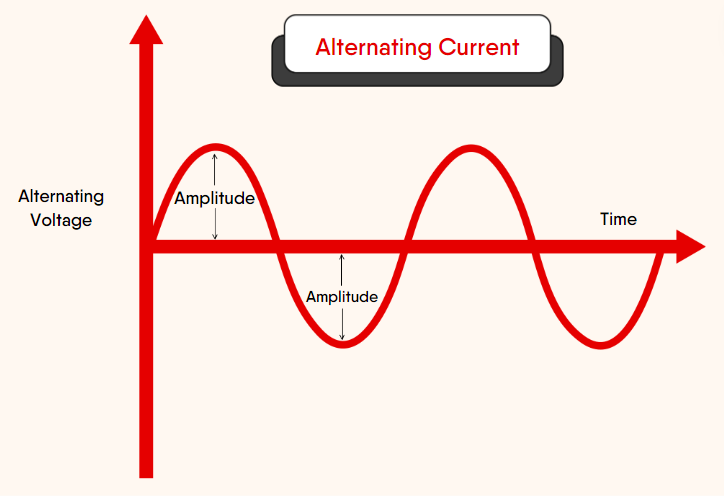
Alternating Current: Meaning, Formation & Characteristics
What is Alternating Current?
An alternating current, or AC, is an electrical current that undergoes periodic changes in magnitude and polarity over time. Unlike direct current or DC, which flows consistently in one direction, AC reverses its direction at regular intervals. This oscillation enables the efficient transmission of electrical energy over long distances and allows for various applications in homes, industries, and power distribution networks.
Definition:
Alternating Current or AC refers to the movement of electric charge that shifts direction periodically.
Planning to set up a Charging station?
Connect with 1C for expert advice on EV chargers
History of Alternating Current
The first alternating current generator was built by Hippolyte Pixii in 1832, based on Michael Faraday’s principles. AC gained traction for electrotherapy in 1855 by Guillaume Duchenne. Further advancements came in the 1870s by Ganz Works and in the 1880s by Sebastian Ziani de Ferranti, Lucien Gaulard, and Galileo Ferraris. Russian engineer Pavel Yablochkov developed an AC lighting system in 1876, and by 1883, the Ganz factory in Hungary had installed over fifty AC lighting systems.
How is Alternating Current Formed?
An alternating current is formed through the process of electromagnetic induction. This occurs when a conductor, which is a coil of wire, is exposed to a changing magnetic field. When the magnetic field around the conductor fluctuates, it induces a voltage or electromotive force (EMF) along the conductor. As a result, electrons within the conductor experience a push or pull, causing them to move back and forth, creating an alternating flow of electric current. This process is fundamental to the operation of generators, where mechanical energy is converted into electrical energy, producing AC output.
Alternating Current Waveform
The alternating current waveform resembles a sinusoidal wave, starting from zero and gradually increasing to its maximum value. It then decreases back to zero, continues to decrease to its minimum (negative maximum) value, and rises again to zero. The waveform is positive in the first half and negative in the second half.

Characteristics of Alternating Current
- Alternating Current periodically changes direction, unlike Direct Current (DC).
- Sinusoidal waveforms commonly represent it.
- AC can vary in frequency, typically 50 or 60 Hertz (Hz) in most power systems.
- Its voltage and current amplitudes fluctuate over time, reaching both positive and negative values.
- AC is used for power transmission over long distances due to its ability to be easily converted to different voltage levels using transformers.
- It is suitable for powering a wide range of electrical devices, from small appliances to industrial machinery.
- AC systems allow for efficient generation, transmission, and distribution of electrical energy.
- The instantaneous power in an AC circuit oscillates between positive and negative values, leading to considerations of reactive power and power factors in AC systems.
Application of Alternating Current
Following are the applications of alternating current:
- AC is commonly used in various household and office appliances.
- Examples of AC applications include audio signals and radio signals.
- AC is preferred for transmitting power over long distances due to its efficiency.
- The ease of generating and transporting AC makes it practical for widespread use.
- AC can be easily converted to and from high voltages using transformers.
- It powers electric motors, converting electrical energy into mechanical energy.
- AC is extensively used in large appliances such as refrigerators and dishwashers.
Planning to set up a Charging station?
Connect with 1C for expert advice on EV chargers
Average Value of AC
The average value of alternating current is determined by calculating the mean of its instantaneous values over a complete cycle. In symmetrical waveforms like sinusoidal AC, the positive and negative half cycles cancel each other out, resulting in an average value of zero over a full cycle. However, since both cycles contribute to doing work, the average value is calculated by considering only the positive half cycle. This simplifies the calculation, providing a meaningful representation of the AC waveform’s average value.
Also Read:
RMS Value of AC
The Root Mean Square or RMS value is calculated as the square root of the mean of the squares of instantaneous values. It serves as a measure of AC power that produces the equivalent heating effect as a corresponding DC power.
AC Power Supply Frequency
The frequency of AC power supply varies globally, mainly at either 50 or 60 Hertz. Some countries, like Japan, have a mix of both. Lower frequencies, like 50 Hz, ease the design of certain electric motors but may cause flickering in lights. Lower frequencies also lead to reduced transmission losses. Different industries may use specialised frequencies, such as 16.7 Hz for European rail systems and 400 Hz for applications like aircraft and spacecraft, offering benefits like reduced weight and smaller AC to DC conversion units.
High-Frequency Effects on AC
Skin Effect: At high frequencies, AC avoids the wire’s centre due to electromagnetic radiation, creating the skin effect.
Surface Flow: At very high frequencies, current primarily flows on the wire’s surface within a few skin depths, impacting effective cross-section.
Techniques to Reduce Radiation Loss
Electric charge under periodic acceleration in alternating current causes radiation of electromagnetic waves, resulting in energy loss. Various techniques are used to reduce radiation loss based on frequency.
- Twisted Pairs: Pairing wires reduces radiation and inductive coupling up to 1 GHz, with balanced signalling to cancel out radiation from each wire.
- Coaxial Cables: Efficient for audio frequencies up to 5 GHz, with inner and outer conductors containing electromagnetic fields, reducing radiation loss.
- Waveguides: Used at microwave frequencies, waveguides lack inner conductors but guide electromagnetic fields to prevent leakage, albeit with losses due to resistance.
Fibre Optics: Employed for frequencies over 200 GHz, fibre optics act as dielectric waveguides, eliminating losses from traditional conductors.
Mathematics of AC Voltage
Alternating currents is characterised by alternating voltages, described mathematically as
v(t) = Vpeak × sin(ωt)
Where:
- Vpeak is the peak voltage (unit: volt).
- ω is the angular frequency (unit: radians per second).
- t is the time (unit: second).
The angular frequency ω is related to the physical frequency f (unit: hertz) by
ω = 2πf
The peak-to-peak value of an AC voltage, Vpp, is the difference between its positive peak and negative peak:
Vpp = 2 × Vpeak
Conclusion
Alternating current is a fundamental aspect of modern electrical systems, characterised by its periodic changes in magnitude and direction. It has a rich history of development and finds widespread use in various applications, from powering household appliances to facilitating long-distance power transmission. Understanding the formation, characteristics, and applications of AC, as well as techniques for reducing radiation loss and the mathematics behind AC voltages, is essential for harnessing its benefits efficiently. AC continues to play a vital role in powering our modern world, driving technological advancements and enabling the efficient generation, transmission, and utilisation of electrical energy.







